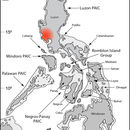pt-BR
nomes no trilho de navegação


According to the IUCN categories and classification structure, we consider the conservation status of this species as “Least Concern (LC),” pending the collection of additional information that might suggest otherwise.
Eutropis multicarinata borealis can be distinguished from congeners by the following combination of characters: (1) body size relatively large (61-97 mm SLV for mature adults); (2) dorsal and lateral scales with 5-7 or rarely 9 keels; (3) usually all head shields or at least posterior one embossed or ridged; (4) 6-7 upper and lower labials; (5) 28-32 midbody scale rows; (6) 36-42 vertebral scale rows between parietals and base of tail; (7) 22-29 lamellae beneath 4th toe; (8) 7-9 lamellae beneath 1st toe; (9) ear moderate, without lobules; (10) interparietal moderate to large, but relatively narrow (Brown & Alcala, 1980).
Color in preservative: Dorsal ground color dark green to brown, usually with dark brown to blackish spots in longitudinal rows; often a light dorsolateral stripe or series of light spots along the upper margin of broad, dark brown to blackish band on lateral surface; anterior upper labials dusky or brownish except for ventral margins; large labial beneath orbit marked by a narrow or dark line along dorsal margin; a light lateral line or band usually evident from region of upper labials or ear to at least for limb; venter grayish tan to bluish slate, with only chin and sometimes preanals marked lighter (Brown & Alcala, 1980).
Eutropis multicarinata borealis is distributed throughout the northern and central islands of the Philippine Archipelago including Luzon, Masbate, Cebu, Negros, Caluya, Semirara, Sicogon, Gigante Norte, and Gigante South Islands.
Luzon and Visayan (Central) Pleistocene Aggregate Island Complexes (PAIC; Brown and Diesmos, 2002).
Eutropis multicarinata borealis ranges from near sea level to about 1200 meters in original and secondary forest, however it can also be found in abaca and coconut groves. It can be found active on the forest floor, low on tree stumps and trunks, and in the axils of abaca leaves, as well as well as beneath leaf litter, rocks, and rotting logs.
Eutropis multicarinata borealis can be distinguished from the other subspecies of Eutropis multicarinata (multicarinata) by the following: (1) interparietal short and small, not separating the parietals; a dark, narrow, vertebral stripe not present; small black spots and blotches under head and chin not present. E. m. borealis occurs on the central and northern islands of the Philippine Archipelago, whereas E. m. multicarinata is known from the southern islands.
This species is oviparous.
61.0-96.9 mm SVL
Subic Bay area, Luzon Island, Philippines; type in the Calfiornia Academy of Sciences
Eutropis borealis is a species of skink. Before being elevated to full-species rank in 2020, it was considered a subspecies of Eutropis multicarinata (formerly Mabuya multicarinata).[1]
Eutropis borealis is endemic to the Philippines and is known from the islands of Catanduanes, Luzon, Polillo, Babuyan Claro, and Batanes. Adults measure 64–83 mm (2.5–3.3 in) in snout–vent length.[1]
Eutropis borealis is a species of skink. Before being elevated to full-species rank in 2020, it was considered a subspecies of Eutropis multicarinata (formerly Mabuya multicarinata).
Eutropis borealis is endemic to the Philippines and is known from the islands of Catanduanes, Luzon, Polillo, Babuyan Claro, and Batanes. Adults measure 64–83 mm (2.5–3.3 in) in snout–vent length.